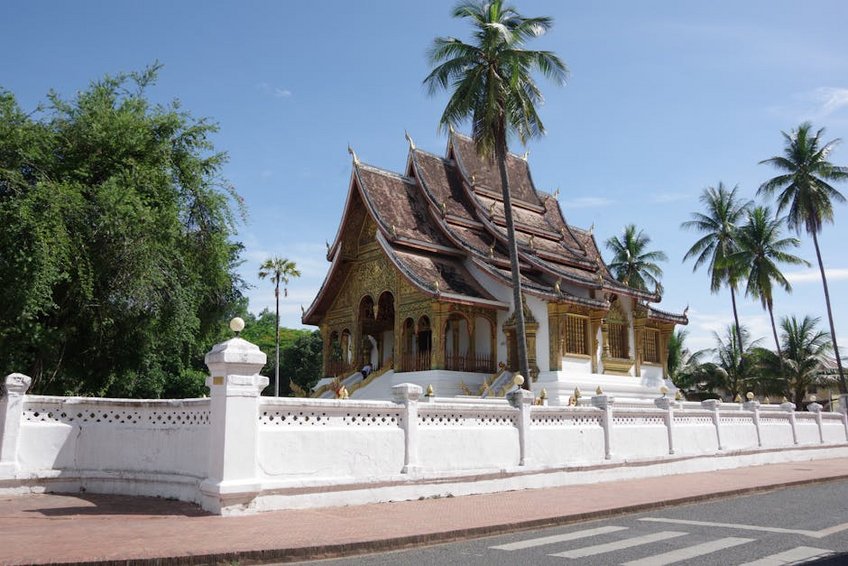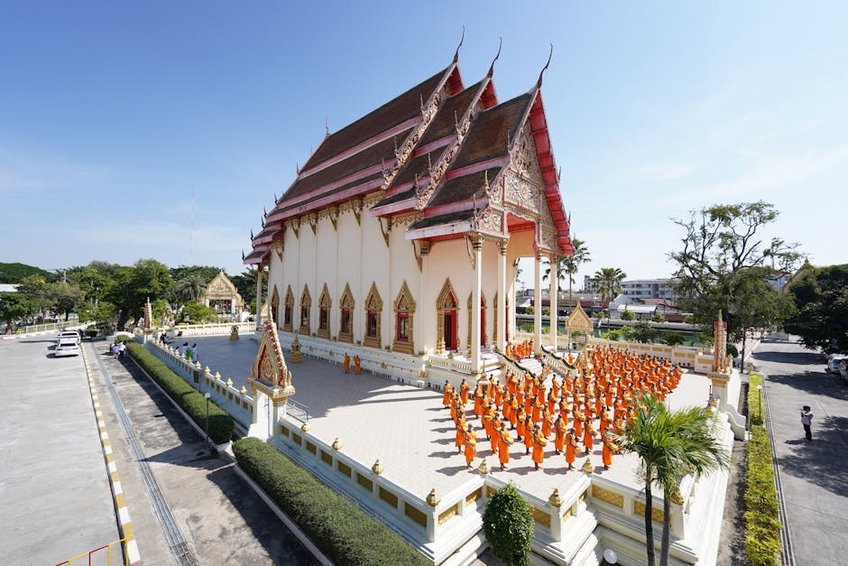Laos Luang Prabang Alms Giving Ceremony: A Spiritual Dawn Experience
Witnessing the Laos Luang Prabang Alms Giving Ceremony offers a profound connection to Buddhist traditions as hundreds of saffron-robed monks walk silently through misty streets at sunrise. This daily Tak Bat ritual provides spiritual insight into Lao culture while demanding respectful observation from visitors who rise before dawn. Your guide covers ceremony etiquette, optimal viewing locations, and integrating this experience into a broader Luang Prabang itinerary.
Essential Information About the Alms Ceremony
The Tak Bat ceremony occurs daily around 5:30-6:30 AM throughout Luang Prabang’s historic peninsula. This Buddhist almsgiving tradition involves local residents offering sticky rice and food to monks who walk in single file lines. Monks receive these offerings as their daily meal while maintaining centuries-old spiritual practices.
Luang Prabang’s UNESCO World Heritage status helps preserve this ritual despite growing tourist attention. The ceremony dates back to 14th-century Lan Xang kingdom origins when Buddhism became Laos’ primary religion. Today approximately 200 monks from various city monasteries participate in the morning procession.
What Is the Tak Bat Ceremony?
Understanding ritual mechanics ensures appropriate participation.
- Local devotees kneel on mats offering cooked rice, fruits, or traditional snacks while monks walk past with alms bowls.
- Monks chant blessings during food acceptance in Pali language without making eye contact with donors.
- The entire procession follows specific routes along Sakkaline Road and surrounding temple pathways.
- Budget travelers spend $25-40 daily using guesthouses, street food, and bicycle rentals while attending free ceremonies.
- Mid-range visitors allocate $60-100 for boutique hotels, guided tours, and restaurant meals with ceremony viewing included.
- Luxury experiences cost $150-300 featuring heritage hotels, private guides, and premium temple visits with ceremonial access.
- Lao Tourism Administration
- Wikitravel Luang Prabang Guide
Historical and Cultural Significance
This Buddhist almsgiving represents the symbiotic relationship between monastic communities and lay supporters. Monks depend entirely on morning offerings for nutritional sustenance throughout each day. Local families gain spiritual merit through consistent participation in this ancient dāna tradition.
The ritual embodies core Buddhist principles of detachment, humility, and community interdependence. Each offering reinforces religious devotion while sustaining monastic life in Luang Prabang. This creates continuous cultural preservation across generations.
Key Ritual Elements and Symbols
Monks wear distinctive saffron robes symbolizing simplicity and spiritual commitment. Their alms bowls typically feature black lacquer with specific ceremonial handling protocols. The procession’s silent movement creates meditative atmosphere before sunrise.
Offerings usually include khao niao sticky rice wrapped in banana leaves or small bamboo containers. Some devotees provide tropical fruits like mangoes or bananas during peak season. The ritual’s visual symbolism photographs beautifully in soft morning light.
Laos Luang Prabang Alms Giving Ceremony – Planning Your Trip
Successful Laos Luang Prabang Alms Giving Ceremony observation requires careful timing between November and February when cooler temperatures (60-80°F/16-27°C) and minimal rainfall improve comfort. Budget $15-30 daily for basic accommodations near the historic center with ceremony access. Reserve flights three months early for December-January peak season visits.
Your Laos Luang Prabang Alms Giving Ceremony experience benefits from hiring local guides who explain cultural nuances. These guides typically charge $10-20 per person for sunrise tours including ritual context. They ensure proper distance and behavior during the sacred event.
Respectful participation means observing from across the street without flash photography or direct interaction. Wear conservative clothing covering shoulders and knees despite early morning humidity. Purchase ceremonial rice from local vendors rather than bringing outside food.
Best Time to Visit for the Ceremony
Visit between November and February for 60-80°F (16-27°C) temperatures and minimal rainfall during dry season. Morning humidity remains manageable around 70% compared to 90% in wet months. These conditions provide comfortable observation without extreme heat.
Shoulder months of March and October offer fewer crowds with temperatures ranging 70-85°F (21-29°C). April through September brings heavy monsoon rains that can disrupt the procession. Plan arrival by 5:15 AM regardless of season for optimal positioning.
Budget Planning and Costs
Daily budgets vary by travel style.
Essential Preparation Checklist
Pack modest clothing with long sleeves and pants despite tropical climate conditions. Bring comfortable sitting cushions since you’ll observe from sidewalks or designated areas. Include mosquito repellent and reusable water bottles for early morning hours.
Secure Laos visa approval before travel since most nationalities require advance authorization. Purchase comprehensive travel insurance covering medical evacuation from remote areas. Download offline maps showing monastery locations and procession routes.

Alt: “luang-prabang-monks-alm-giving-procession-dawn”
Top Attractions and Activities in Luang Prabang
Luang Prabang offers numerous cultural sites beyond the morning alms ritual within its compact historic center. The former royal capital features over thirty active temples with distinctive Lao-Lanna architecture styles. These spiritual centers welcome visitors during daylight hours with modest entry fees.
Many travelers combine ceremony observation with afternoon visits to Kuang Si Waterfalls located 18 miles southwest. These turquoise cascades feature multiple swimming areas and bear rescue center access. Local tuk-tuk services provide round-trip transportation for $10-15 per person.
Must-See Highlights
Wat Xieng Thong represents Luang Prabang’s most significant temple with intricate mosaic work and royal history. This 16th-century complex opens daily from 8 AM to 5 PM with $3 admission supporting preservation. Morning visits avoid peak crowds from tour groups.
Mount Phousi provides panoramic city views accessible via 328-step staircase near the night market. Sunrise or sunset ascents cost $2 with limited crowding during early hours. The summit features small Buddha footprints and shrine areas.
Royal Palace Museum displays Lao monarchy artifacts within beautifully preserved 1904 building. Entry costs $4 including required bag storage and modest dress code enforcement. Allocate ninety minutes for comprehensive exhibition viewing.
Hidden Gems and Local Favorites
Ban Xang Khong weaving village located across the Mekong River showcases traditional textile production. Local artisans demonstrate silk weaving techniques using natural dyes from 8 AM to 5 PM daily. Take the $1 ferry crossing for authentic cultural immersion.
UXO Lao Visitor Center educates about unexploded ordnance clearance efforts with free admission. This sobering but important exhibit operates Monday-Friday from 8 AM to 4 PM. Donations support ongoing bomb removal programs.
Cultural Workshops and Experiences
Tamarind Cooking Classes offer half-day Lao cuisine instruction using market-fresh ingredients. These $25 sessions include herb garden tours and recipe booklets. Morning classes conclude with lunch featuring dishes you prepared.
Ock Pop Tok Living Crafts Center provides textile dyeing workshops in beautiful Mekong riverside setting. Two-hour sessions cost $15 using natural materials like indigo and turmeric. Their fair trade shop supports local artisans.
Practical Travel Information
Luang Prabang International Airport (LPQ) receives flights from Bangkok, Hanoi, and Siem Reap with visa-on-arrival availability. The compact city center measures approximately 1.5 square miles allowing easy walking between most attractions. Tuk-tuks provide affordable transport for longer distances.
Accommodation options range from $10 hostel dorms to $300 luxury resorts with most mid-range hotels clustering near the peninsula tip. Book three months early for November-March high season visits. Many properties offer free bicycle rentals for guest use.
| Category | Options/Features | Price Range (USD) |
|---|---|---|
| Budget Accommodation | Guesthouses with fan rooms, shared bathrooms, central location | $10-25 |
| Mid-Range Hotels | Private bathrooms, air conditioning, breakfast included, pool access | $40-80 |
| Luxury Resorts | River views, spa services, fine dining, cultural activities | $120-300 |
| Transportation | Tuk-tuks, bicycles, private cars, boat trips | $2-50 |


